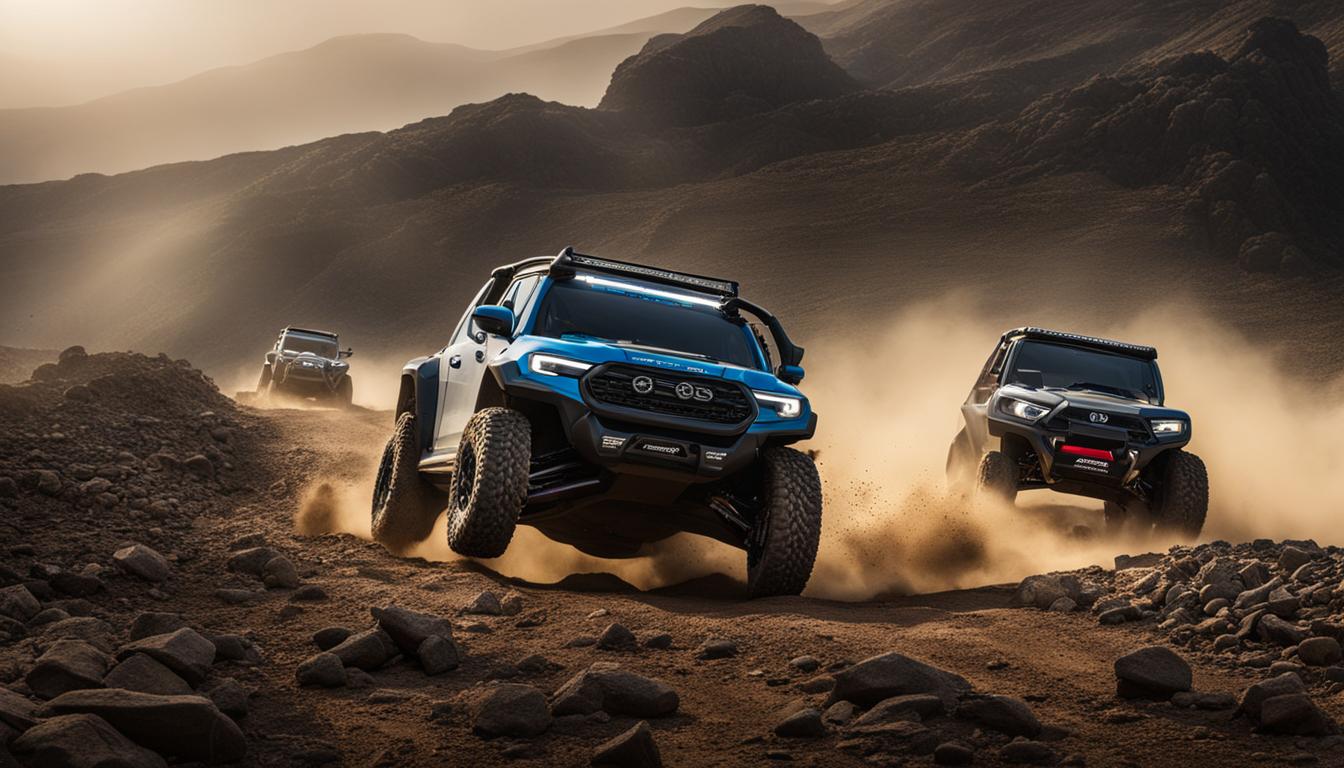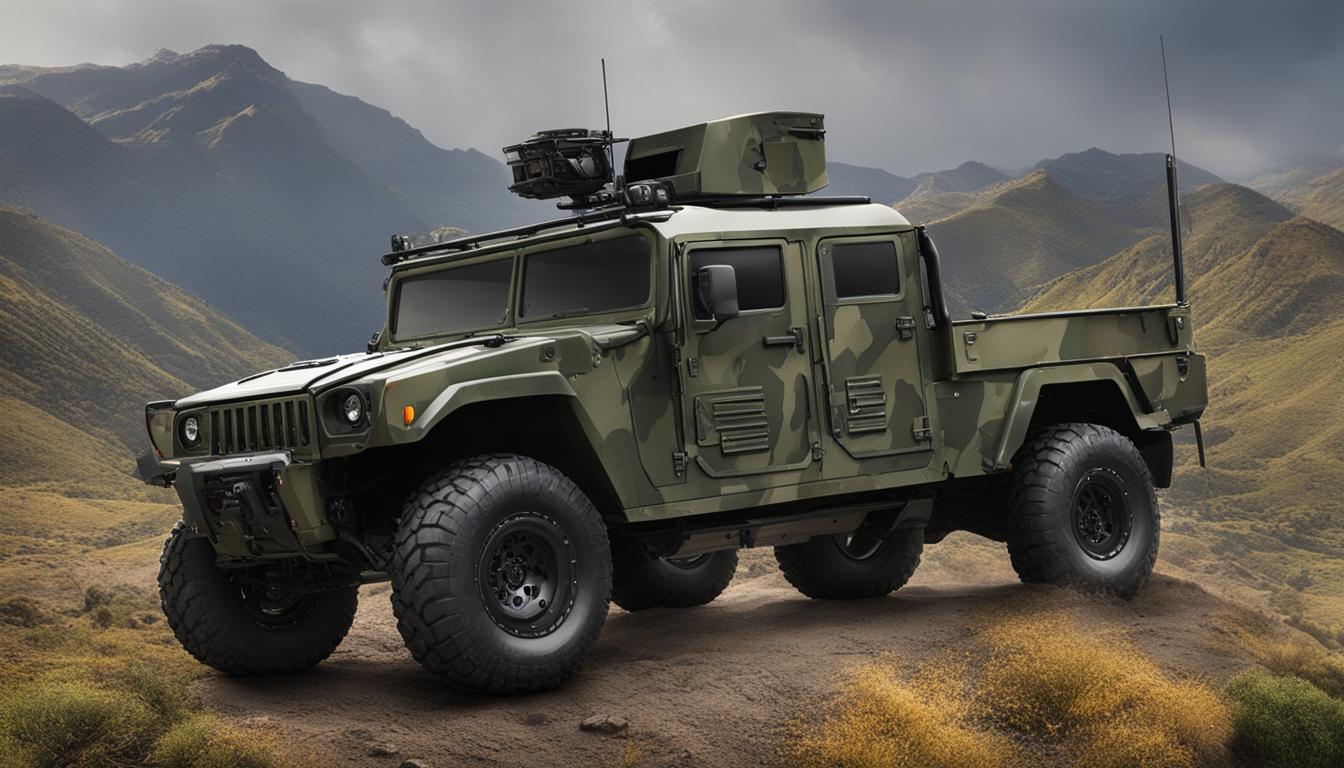When it comes to off-roading, there is an ongoing discussion about the pros and cons of short wheelbase (SWB) and long wheelbase (LWB) vehicles. While there is no definitive answer as to which is better, it ultimately depends on the individual’s preferences and needs. Both options have their own unique advantages and disadvantages that cater to specific off-roading scenarios.
Key Takeaways:
- Short wheelbase (SWB) vehicles offer better maneuverability and a smaller turning radius, making them ideal for tight and technical off-roading.
- SWB vehicles have a larger breakover angle, allowing them to clear obstacles more easily.
- However, SWB vehicles have limited cargo space and may be less comfortable on the road.
- Long wheelbase (LWB) vehicles provide more stability and are less likely to roll over.
- LWB vehicles offer more space for gear and provide a smoother ride experience.
- LWB vehicles are better suited for activities such as camping, cruising dirt roads, and towing.
- The choice between SWB and LWB vehicles depends on the specific needs and preferences of the off-roader.
In the following sections, we will delve deeper into the specific advantages and off-road capabilities of both short wheelbase and long wheelbase vehicles, helping you make an informed decision based on your individual requirements. So, let’s explore the differences between SWB and LWB vehicles in off-roading!
Advantages of Short Wheelbase in Off-Roading
Short wheelbase vehicles offer several advantages that make them desirable for off-roading enthusiasts. Their compact size and shorter distance between the front and rear axles provide enhanced maneuverability, allowing drivers to navigate tight and technical terrains with ease. With a smaller turning radius, these vehicles can easily make sharp turns, making them ideal for off-road trails that require quick changes in direction.
One of the key advantages of short wheelbase vehicles in off-roading is their ability to overcome obstacles. Due to their shorter length, these vehicles have a larger breakover angle, which refers to the maximum angle a vehicle can traverse without being grounded. This means that short wheelbase vehicles can more easily clear rocks, logs, and other obstacles on the trail, ensuring a smoother and more uninterrupted off-road experience.
In addition to their maneuverability and obstacle-clearing capabilities, short wheelbase vehicles also have the advantage of being nimble in tight spaces. Whether it’s navigating narrow trails or squeezing through dense vegetation, the compact size of these vehicles allows for greater agility, making them well-suited for exploring off-road areas that may be inaccessible to larger, long wheelbase vehicles.
| Advantages of Short Wheelbase in Off-Roading: |
|---|
| Enhanced maneuverability |
| Smaller turning radius |
| Larger breakover angle for obstacle clearance |
| Nimble and agile in tight spaces |
While short wheelbase vehicles excel in these areas, it’s important to note that they do have their limitations. Due to their compact size, they typically have limited cargo space, making them less suitable for long off-road trips that require carrying a significant amount of gear or supplies. Additionally, their shorter wheelbase can result in a less comfortable on-road driving experience compared to longer wheelbase vehicles.
Ultimately, the decision between short wheelbase and long wheelbase vehicles in off-roading comes down to personal preferences and specific needs. Short wheelbase vehicles are the preferred choice for off-roaders looking for maneuverability, agility, and the ability to conquer technical terrains with ease. On the other hand, long wheelbase vehicles offer greater stability, more cargo space, and a smoother ride, making them better suited for extended off-road trips and activities such as camping or towing.
When choosing the right wheelbase for off-roading, it’s essential to consider the type of off-roading you plan to engage in and your individual requirements. Assessing the terrain, obstacles, cargo needs, and comfort preferences will help you make an informed decision that aligns with your off-roading goals. Remember, both short and long wheelbase vehicles have their own unique advantages, and the best choice ultimately depends on what matters most to you as an off-roading enthusiast.
Off-Road Capabilities of Short Wheelbase
The off-road capabilities of short wheelbase vehicles make them a force to be reckoned with on challenging terrains. With their compact size and nimble nature, these vehicles excel at maneuvering through tight and technical off-road trails. Short wheelbase vehicles offer several advantages that contribute to their off-road prowess.
- Improved Maneuverability: Short wheelbase vehicles have a tighter turning radius, allowing them to navigate narrow paths and make sharp turns with ease. This agility enables off-roaders to tackle tricky obstacles and tight corners more effectively.
- Enhanced Breakover Angle: The larger breakover angle of short wheelbase vehicles enables them to conquer steep inclines and overcome obstacles such as rocks and logs. This capability is vital for off-roading enthusiasts who frequently encounter challenging terrains.
However, it’s important to note that short wheelbase vehicles also have limitations. Due to their compact size, they may have limited cargo space, making them less suitable for extended off-road trips that require carrying a significant amount of gear. Additionally, their shorter wheelbase can result in a less comfortable ride on rough and uneven surfaces.
In contrast, long wheelbase vehicles offer different advantages and excel in certain off-roading scenarios. Their longer wheelbase provides more stability, reducing the risk of rollovers. This makes them a preferred choice for off-roaders who prioritize safety and stability while navigating uneven and unpredictable terrains. Moreover, long wheelbase vehicles typically offer more cargo space, allowing for the transportation of additional gear and equipment.
In summary, short wheelbase vehicles are well-suited for tight and technical off-roading, thanks to their improved maneuverability and larger breakover angle. However, they may have limitations in terms of cargo space and ride comfort. On the other hand, long wheelbase vehicles provide enhanced stability and greater cargo capacity, making them ideal for activities such as camping, cruising dirt roads, and towing. The choice between short wheelbase and long wheelbase ultimately depends on the individual’s specific off-roading needs and preferences.
Benefits of Long Wheelbase in Off-Roading
Long wheelbase vehicles offer unique benefits that make them suitable for specific off-roading needs. One of the key advantages of a long wheelbase is its enhanced stability, which significantly reduces the risk of rollovers. This added stability is especially crucial when tackling uneven or challenging off-road terrains, providing off-roaders with a greater sense of confidence and security.
Another benefit of long wheelbase vehicles is their ability to provide a smoother ride experience. The longer distance between the front and rear axles helps to absorb bumps and vibrations, resulting in improved comfort for both the driver and passengers. This feature is particularly advantageous for longer off-road trips, as it reduces fatigue and allows for a more enjoyable journey.
In addition to stability and comfort, long wheelbase vehicles offer ample space for gear and equipment. This is especially valuable for off-roaders who engage in activities such as camping or overland expeditions, where carrying sufficient supplies and equipment is essential. The increased cargo capacity of long wheelbase vehicles allows for easier storage and transportation of gear, ensuring that off-roaders can comfortably embark on extended adventures.
While short wheelbase vehicles excel in maneuverability and agility, long wheelbase vehicles have their own set of strengths that cater to specific off-roading requirements. From enhanced stability to a smoother ride and increased cargo space, long wheelbase vehicles offer key benefits that are invaluable for off-roaders seeking a more comfortable and versatile off-road experience.
Off-Road Capabilities of Long Wheelbase
Long wheelbase vehicles excel in certain off-road scenarios, providing enhanced stability and versatility. Their extended wheelbase allows for a smoother ride, reducing the risk of rollovers and enhancing overall safety. This makes them particularly suitable for activities such as camping, cruising dirt roads, and towing.
One of the key advantages of long wheelbase vehicles in off-roading is their ability to maintain stability on uneven terrain. The longer distance between the front and rear axles distributes weight more evenly, preventing the vehicle from tipping over. This is especially beneficial when navigating steep inclines or traversing rocky surfaces.
Off-Road Stability: Short Wheelbase vs Long Wheelbase
In addition to stability, long wheelbase vehicles offer increased load-carrying capacity. The extra space allows for the transportation of more gear, making them ideal for longer off-road trips or hauling equipment. Whether it’s camping supplies, adventure gear, or tools, there’s ample space to accommodate everything you need for an extended adventure.
While long wheelbase vehicles may not possess the same nimble maneuverability as their short wheelbase counterparts, their adaptability in diverse off-road conditions is undeniable. They provide a smoother ride experience, allowing occupants to travel more comfortably for longer periods. Moreover, their longer wheelbase offers more traction and reduces the chances of getting stuck in difficult off-road situations.
| Short Wheelbase (SWB) | Long Wheelbase (LWB) |
|---|---|
| Improved maneuverability | Enhanced stability |
| Smaller turning radius | Reduced risk of rollovers |
| Greater breakover angle | Smoother ride |
| Limitations in cargo space | Increased load-carrying capacity |
When it comes to choosing between short wheelbase and long wheelbase vehicles for off-roading, it ultimately depends on your individual preferences and needs. If you prioritize maneuverability and tackling tight, technical terrains, a short wheelbase vehicle may be the better option. However, if you value stability, comfort, and the ability to carry more gear, a long wheelbase vehicle would be more suitable. Consider the specific off-road activities you plan to engage in and weigh the advantages and disadvantages of each to make an informed decision that aligns with your requirements.
Comparing Short Wheelbase and Long Wheelbase
Let’s compare short wheelbase and long wheelbase vehicles to determine which one suits your off-roading adventures better. When it comes to off-roading, there is an ongoing debate between these two vehicle types. While there is no definitive answer, understanding their differences and advantages can help you make an informed decision.
Short Wheelbase (SWB) Vehicles
Short wheelbase vehicles offer several benefits for off-roading enthusiasts. With their shorter wheelbase, these vehicles excel in maneuverability, making them ideal for tight and technical terrains. Their smaller turning radius allows for quick and agile navigation through challenging paths. Moreover, short wheelbase vehicles boast a larger breakover angle, enabling them to conquer obstacles with ease. If you enjoy tackling rugged and adventurous off-road trails that demand agility and quick maneuvering, a short wheelbase vehicle might be the perfect fit for you.
Long Wheelbase (LWB) Vehicles
On the other hand, long wheelbase vehicles provide their own set of advantages. Due to their longer wheelbase, these vehicles offer enhanced stability, reducing the risk of rollovers in uneven or steep terrains. If you prefer a smoother ride experience, especially when driving at higher speeds on dirt roads, a long wheelbase vehicle can provide better comfort. Additionally, LWB vehicles offer more cargo space to accommodate gear for extended off-road trips or equipment for towing activities. These vehicles are often favored by off-roaders who enjoy camping, cruising on dirt roads, or require the versatility to handle towing needs during their adventures.
In summary, short wheelbase vehicles excel in maneuverability and navigating tight off-road trails, while long wheelbase vehicles provide stability and comfort for extended trips and towing. When making a decision between the two, consider your preferences, specific off-roading needs, and the types of terrains you plan to explore. Both options have their strengths, so choose the one that aligns with your off-roading goals and enhances your overall experience. Happy off-roading!
Choosing the Right Wheelbase for Off-Roading
Choosing the right wheelbase is crucial for maximizing your off-roading experience; let’s explore the factors to consider. When deciding between a short wheelbase (SWB) and a long wheelbase (LWB) vehicle, it’s important to evaluate your off-roading needs and preferences.
- Terrain: Consider the type of off-roading you’ll be doing. If you’ll be tackling tight and technical trails that demand agility and quick maneuvering, a SWB vehicle may be the better choice. On the other hand, if you plan on camping, cruising dirt roads, or towing heavy loads, a LWB vehicle may offer more stability and cargo space.
- Maneuverability: SWB vehicles excel in tight spots due to their smaller turning radius and improved maneuverability. They can easily navigate around obstacles and make sharp turns, making them ideal for off-road enthusiasts who prefer challenging and technical trails.
- Comfort and Space: LWB vehicles provide a smoother and more comfortable ride, thanks to their longer wheelbase and improved stability. They offer more interior space for passengers and cargo, making them a better choice for extended off-road trips or when you need to carry additional gear.
Consider these factors and find the right balance between maneuverability, comfort, and cargo space. Remember that there is no definitive answer as to which wheelbase is better for off-roading. It ultimately comes down to your individual needs, preferences, and the specific off-roading activities you plan to undertake.
| Short Wheelbase (SWB) | Long Wheelbase (LWB) |
|---|---|
| Improved maneuverability | Enhanced stability |
| Smaller turning radius | Reduced risk of rollovers |
| Ability to navigate tight and technical terrain | Smoother ride experience |
| Larger breakover angle for overcoming obstacles | More space for gear and cargo |
The table above summarizes the key differences between SWB and LWB vehicles in off-roading. Use it as a reference to help you make an informed decision based on your off-roading requirements. Ultimately, the right wheelbase choice will enhance your off-roading experience and allow you to conquer the trails with confidence.
Conclusion
Ultimately, the choice between short wheelbase and long wheelbase vehicles in off-roading boils down to finding the optimal balance between maneuverability, stability, and cargo space that aligns with your specific off-road needs.
Short wheelbase vehicles, with their compact size and smaller turning radius, excel in tight and technical off-road situations. They offer improved maneuverability, allowing you to navigate challenging terrains with ease. Their larger breakover angle also helps them overcome obstacles, ensuring a smoother ride.
However, it’s important to note that short wheelbase vehicles may have limited cargo space and can be less comfortable on the road compared to their long wheelbase counterparts.
Long wheelbase vehicles, on the other hand, provide enhanced stability and are less likely to roll over. They offer ample space for gear and provide a smoother ride, making them an excellent choice for activities such as camping, cruising dirt roads, and towing.
Ultimately, the choice between a short wheelbase and long wheelbase vehicle depends on your specific off-roading needs. If you’re looking for nimble maneuverability and the ability to tackle tight and technical terrains, a short wheelbase vehicle is the way to go. However, if you prioritize stability, comfort, and the capacity to carry more gear, a long wheelbase vehicle is the better option.
It’s essential to consider your personal preferences, the type of off-roading you’ll be doing, and the specific capabilities you require before making a decision. By understanding the advantages and disadvantages of both short wheelbase and long wheelbase vehicles, you can select the right option that suits your off-road adventures perfectly.
FAQ
Are short wheelbase vehicles better for off-roading?
Short wheelbase vehicles are generally considered better for tight, technical off-roading. Their shorter wheelbase provides better maneuverability, a smaller turning radius, and a larger breakover angle for easier obstacle clearance.
What are the advantages of long wheelbase vehicles in off-roading?
Long wheelbase vehicles offer more stability and are less likely to roll over. They also provide a smoother ride experience and have more space for gear, making them suitable for activities such as camping, cruising dirt roads, and towing.
Which type of vehicle is better for off-roading?
There is no definitive answer as to which type of vehicle is better for off-roading. It ultimately depends on individual preferences and needs. Short wheelbase vehicles excel in tight, technical off-roading, while long wheelbase vehicles are better suited for camping, cruising dirt roads, and towing.
What should I consider when choosing a wheelbase for off-roading?
When choosing a wheelbase for off-roading, consider the type of off-roading you’ll be doing, your personal preferences, and the desired capabilities. Assess factors such as maneuverability, stability, cargo space, and comfort to make an informed decision that meets your specific off-roading needs.
 Skip to main content
Skip to main content


